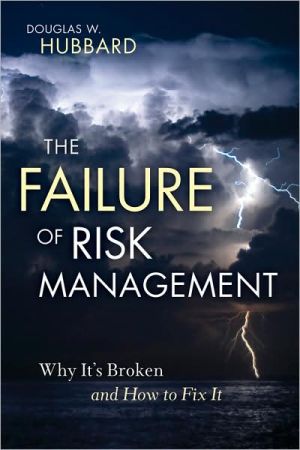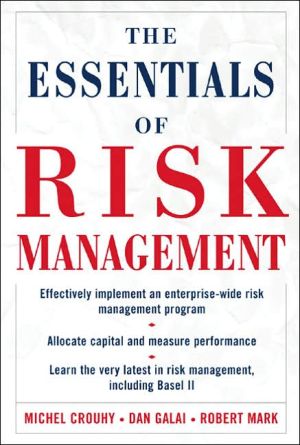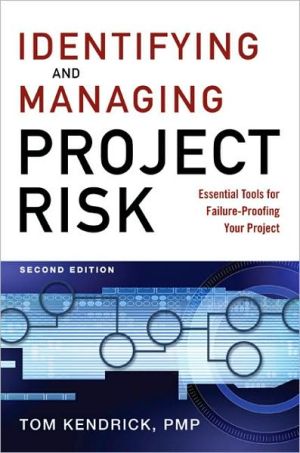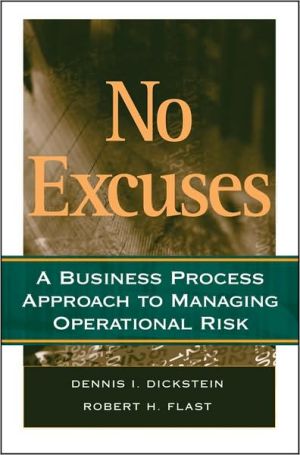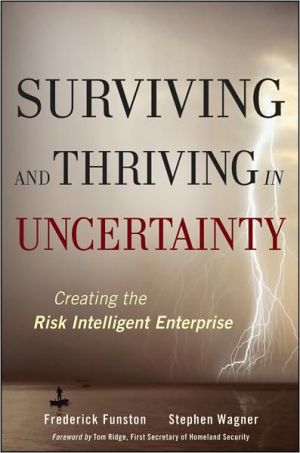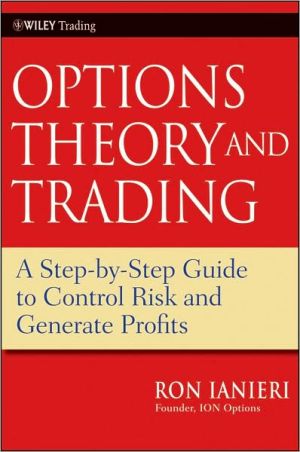The Failure of Risk Management: Why It's Broken and How to Fix It
The Failure of Risk Management explains which risk analysis methods work, which don't, and how to tell the difference. The Failure of Risk Management discusses topics relevant to the management of any risk including: Financial Risks, Natural Disasters, Industrial Accidents, Product Safety, Technology Risks, Project Failures, Engineering Disasters, Pandemic Viruses, Computer Security, Fraud, Loss of Reputation, Litigation\ Companion Web site www.howtofixriskmgt.com\ YOUR BIGGEST RISK IS THAT...
Search in google:
The 2008 credit crisis, terrorism, Katrina, computer hackers, and air travel disasters all have something in common-the methods used to assess and manage these risks are fundamentally flawed. If risks cannot be properly evaluated, risk management itself becomes the biggest risk. The Failure of Risk Management shows you how to identify and fix these hidden problems in risk management. Ineffective risk management methods, often touted as "best practices," are passed from company to company like a bad virus with a long incubation period: there are no early indicators of ill effects until it's too late and catastrophe strikes. Exploring why risk management fails—the failure to measure and validate methods as a whole or in part; the use of components known not to work; and not using components that are known to work—The Failure of Risk Management shows you how to measure the performance of risk management in a meaningful way, identify where risk management is broken, and fix it. Respected expert and bestselling author Douglas Hubbard-creator of the critically praised Applied Information Economics (AIE)—uses real-world examples to reveal the serious problems in our current approaches to risk analysis. Hubbard skillfully illustrates how to use a calibrated risk analyses approach, and the many benefits that go along with it, along with checklists and practice examples to get you started. One of the first resources to apply risk management across all industries, The Failure of Risk Management provides you with the tools you need to hit the ground running with radically better risk management solutions. Here, you'll discover:The diversity of approaches to assess and mitigate risksWhy many influential methods-both qualitative and quantitative don't workWhy we shouldn't always trust assessments based on "experience" aloneThe fallacies that stop you from adopting better risk management methodsHow those who develop models of risks justify (in error) excluding the biggest risksAdding empirical science to risk management
Preface xiAcknowledgments xvPart 1 An Introduction to the Crisis 1Chapter 1 Healthy Skepticism for Risk Management 3Common Mode Failure 4What Counts as Risk Management 8Anecdote: The Risk of Outsourcing Drug Manufacturing 11What Failure Means 16Scope and Objectives of This Book 18Chapter 2 Risk Management: A Very Short Introduction to Where We've Been and Where (We Think) We Are 21The Entire History of Risk Management (in 800 Words or Less) 22Methods of Assessing Risks 24Risk Mitigation 26The State of Risk Management According to Surveys 31Chapter 3 How Do We Know What Works? 37An Assessment of Self-Assessments 37Potential Objective Evaluations of Risk Management 42What We May Find 49Part 2 Why It's Broken 53Chapter 4 The "Four Horsemen" of Risk Management: Some (Mostly) Sincere Attempts to Prevent an Apocalypse 55Actuaries 57War Quants: How World War II Changed Risk Analysis Forever 59Economists 63Management Consulting: How a Power Tie and a Good Pitch Changed Risk Management 68Comparing the Horsemen 74Major Risk Management Problems to Be Addressed 76Chapter 5 An Ivory Tower of Babel: Fixing the Confusion about Risk 79The Frank Knight Definition 81Risk as Volatility 84A Construction Engineering Definition 86Risk as Expected Loss 86Risk as a Good Thing 88Risk Analysis and Risk Management versus Decision Analysis 90Enriching the Lexicon 91Chapter 6 The Limits of Expert Knowledge: Why We Don't Know What We Think We Know about Uncertainty 95The Right Stuff: How a Group of Psychologists Saved Risk Analysis 97Mental Math: Why We Shouldn't Trust theNumbers in Our Heads 99"Catastrophic" Overconfidence 102The Mind of "Aces": Possible Causes and Consequences of Overconfidence 107Inconsistencies and Artifacts: What Shouldn't Matter Does 111Answers to Calibration Tests 115Chapter 7 Worse Than Useless: The Most Popular Risk Assessment Method and Why It Doesn't Work 117A Basic Course in Scoring Methods (Actually, It's the Advanced Course, Too-There's Not Much to Know) 118Does That Come in "Medium"?: Why Ambiguity Does Not Offset Uncertainty 123Unintended Effects of Scales: What You Don't Know Can Hurt You 130Clarification of Scores and Preferences: Different but Similar-Sounding Methods and Similar but Different-Sounding Methods 135Chapter 8 Black Swans, Red Herrings, and Invisible Dragons: Overcoming Conceptual Obstacles to Improved Risk Management 145Risk and Righteous Indignation: The Belief that Quantitative Risk Analysis Is Impossible 146A Note about Black Swans 151Frequentist versus Subjectivist 158We're Special: The Belief that Risk Analysis Might Work, But Not Here 161Chapter 9 Where Even the Quants Go Wrong: Common and Fundamental Errors in Quantitative Models 167Introduction to Monte Carlo Concepts 168Survey of Monte Carlo Users 172The Risk Paradox 174The Measurement Inversion 176Where's the Science? The Lack of Empiricism in Risk Models 178Financial Models and the Shape of Disaster: Why Normal Isn't so Normal 181Following Your Inner Cow: The Problem with Correlations 187"That's Too Uncertain": How Modelers Justify Excluding the Biggest Risks 191Is Monte Carlo Too Complicated? 195Part 3 How to Fix It 199Chapter 10 The Language of Uncertain Systems: The First Step Toward Improved Risk Management 201Getting Your Probabilities Calibrated 203The Model of Uncertainty: Decomposing Risk with Monte Carlos 208Decomposing Probabilities: Thinking about Chance the Way You Think about a Budget 212A Few Modeling Principles 213Modeling the Mechanism 215Chapter 11 The Outward-Looking Modeler: Adding Empirical Science to Risk 221Why Your Model Won't Behave 223Empirical Inputs 224Introduction to Bayes: One Way to Get around that "Limited Data for Disasters" Problem 227Self-Examinations for Modelers Who Care about Quality 233Chapter 12 The Risk Community: Intra-and Extraorganizational Issues of Risk Management 241Getting Organized 242Managing the Global Probability Model 244Incentives for a Calibrated Culture 250Extraorganizational Issues: Solutions beyond Your Office Building 254Miscellaneous Topics 256Final Thoughts on Quantitative Models and Better Decisions 258Appendix Calibration Tests and Answers 261Index 273
